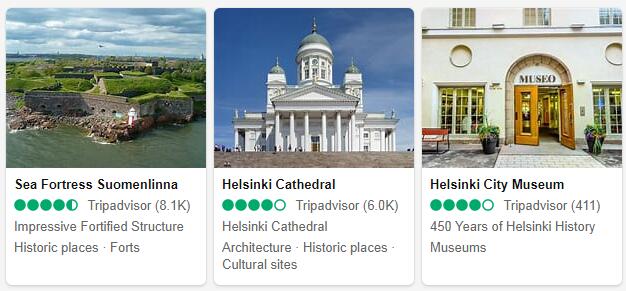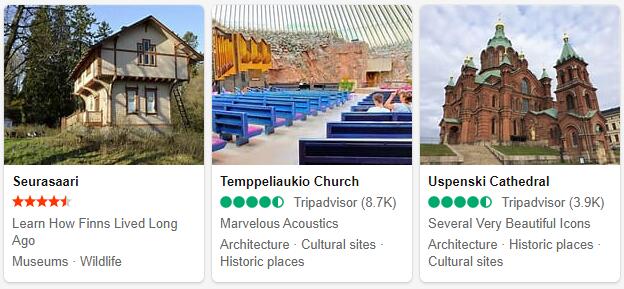Attractions in Helsinki
Helsinki has a number of great services and attractions, whether you are looking for nature experiences, fantastic buildings or exciting museums.
Suomenlinna
On an island just outside Helsinki lies one of the city’s most interesting attractions, the old coastal fortress Suomenlinna, or Sveaborg, as it is also called. This star-shaped fortress was to defend the country against Russia.
Today, this is a popular getaway spot, with several restaurants, museums and cafes, and great views of the sea. Soumenlinna is included on UNESCO’s World Heritage List. You take a boat here from the harbor at the Market Square. Open year round from 1000 to 1600, and to 1800 in the summer. Entry about 40 kroner, depending on which museums you want to visit.
Tuomiokirkko
Helsinki’s perhaps most striking building is the Chalk White Lutheran Cathedral, Tuomiokirkko, which is at the top of a long, wide staircase in Senate Square. The church was built in the 1840s and has become both a landmark and a symbol of the city.
Uspenski Cathedral
Many may be surprised to see a large Russian Orthodox cathedral with large, golden loop domes in the middle of Helsinki, but considering Finland’s close ties and location to Russia, it is really no wonder. Completed in 1868, the Uspenski Cathedral is perfectly situated on a hilltop at the harbor with great views.
Free admission. Open from 0930 to 1600 Monday to Friday, to 1400 on Saturdays, and from 1200 to 1500 on Sundays. Closed on Mondays during winter. The address is Kanalgatan 1. See photo of Uspenski Cathedral first in the article.
Fish market
Just off the Uspenski Cathedral is Helsinki’s lively fish market, where fruits and vegetables, crafts and souvenirs, meat and garments are also sold. From the harbor there are boats to the islands around Helsinki, and also to Stockholm, Tallinn and St. Petersburg in Russia.
Tempel Kyrkan
We must mention a third church, which you have certainly not seen in the Nordic countries. The Lutheran Temple Church has been blasted out into a solid rock and is a very popular tourist attraction.
On Sundays, classical concerts are arranged here, and the special copper dome that makes up the ceiling provides a wonderful acoustic. Address: Lutherinkatu, (eg Fredriki nkatu from the center of Helsinki and right at the church).
Linnanmäki Amusement Park
The country’s oldest amusement park is called Linnanmäki. The park has free entrance, but use of the attractions depends on age and height. The theme park is only open from April to September. In the winter months, however, they can offer other snow-based activities such as snow sculptures, mini slalom, roller coasters and more. Address: Tivolikuja 1
Sea Life
Just off Linnanmäki you will find the large aquarium Sea Life which is open from 1000 every day, all year round. Here you can see everything from sea creatures from shark to seahorses and jellyfish. Entry about NOK 100 for adults, NOK 75 for children and students. Address: Tivolitie 10.
Serena Water Amusement Park
Espoo, just outside Helsinki, is the Nordic region’s largest water park, Serena Water Amusement Park, with several swimming pools, water slides, hot tubs and saunas. Open every day from 11am to 8pm, and an all-day ticket does not cost the whole world. Address: Tornimäentie 10, 02970 ESPOO
Helsinki Zoo
Helsinki Zoo is located on the island of Korkeasaari just outside the city center. Entry ticket including ferry transport costs about 100 NOK, children between 7 and 16 half price, free for the little ones. Open from 1000 all days throughout the year. How long the park is open is seasonal.
Ateneum – The Finnish National Gallery
In Atenum you can see Finnish art from the 18th century up to the 1950s. This is the country’s largest art collection with works by Edelfelt, Simberg, Gallen-Kallela and Schjerfbeck. The gallery is located in Kaivokatu 2. Entrance approx. NOK 60, closed on Mondays.
Sibelius Monument
In Sibelius Park lies an unusual monument of Finland’s foremost composer, Jean Sibelius (1865-1957). This is almost like a large church organ, and makes a kind of music as the wind blows through the pipes.
The Sibelius Monument was quite contentious at the unveiling in 1967, to say the least. In Sibelius Park there is also a regular statue of Sibelius. The park is otherwise a pleasant green lung in an already green city, and is popular for day trips and barbecues.
Tourist in Helsinki
If you plan to get as many of Helsinki’s attractions as possible within a few days, investing in the Helsinki card will pay off. This card gives you free access to over fifty museums and area attractions, and free use of public transport. You also get discounts on sightseeing tours and many restaurants and shops.
At the time of writing, the Helsinki card costs 44 euros for a 24-hour pass, 54 euros for a 48-hour, and 64 euros for a 72-hour pass. The price for children between 7 and 16 is half, while the youngest go for free in most places. Check the updated exchange rate here!
It should be no problem for a fairly pedestrian to experience most of the attractions in downtown Helsinki on foot. However, if you want guided transport with information about the sights, consider buying a 24-hour ticket for the city’s sightseeing buses. These start at Senate Square, and have ten regular stops where you can hop off, be as long as you want and hop on the next bus again.
Or you can take the “pub trikk” Spårakoff which serves all types of drinks, while you get a 40 minute tour of the city center. It’s a find!
Day 1 in Helsinki
Start your day in the heart of Helsinki, the historic center around Senate Square. The first building you notice is the Chalk White Lutheran Cathedral, Tuomiokirkko, which is at the top of a long, wide staircase at Senate Square. The church was built in the 1840s and has become both a landmark and a symbol of the city. Here are also parts of the University, from 1832.
On a hill just southeast of Senate Square is the Uspenski Cathedral, a clear legacy of the years under Russian rule, with its large loop domes. This is the largest Orthodox church in Western Europe, and was built in the 1860s. Free admission, but closed on Mondays.
From here you can walk down to the Market Square at the harbor of Helsinki, where it is normally buzzing with life. Here is the town’s fish market, where fruits and vegetables, crafts and souvenirs, meat and clothing are also sold. Afterwards, you can stroll up to Senate Square again and move west through the shopping streets Alexandersgatan or Esplanadis. There are plenty of shops where you can shop if you want, or places to sit down for a coffee or lunch.
Continue west along the Bulevardi and you will reach the Hietalahti Market Hall. Here there are very low prices and a huge selection. There are many other specialty shops in the Punavuori area.
Just to the north is another of Helsinki’s foremost sights, the Lutheran Temppeliaukio Church, which has been blasted out into a rock. Behind the altar you can only see a massive rock wall. The church was opened in 1969 and receives over half a million tourists annually.
If you continue north, you will come to Sibeliusparken, where you can see one of the most special memorials dedicated to a Nordic person. The monument to Finland’s foremost composer Jean Sibelius (1865-1957) looks almost like a large church organ, and makes a kind of music as the wind blows through the pipes. The Sibelius monument was quite disputed at the unveiling in 1967. There is also a regular statue of Sibelius in the park. The park is otherwise a pleasant green lung in an already green city, and is popular for picnics and barbecues in the summer.
In the evening, it’s time to test one of Helsinki’s better restaurants, and why not try something you can’t find at home? Why not try something you are guaranteed not to eat at home? In the street Rahapajankatu 3 in Helsinki you will find a restaurant more Russian than those found in Russia. In fact, safe sources, so-called rumors, say that this is the oldest Russian restaurant outside Eastern Europe. Closed Sundays and Mondays. Read more on the website of Ravintola Bellevue.
If you want to try Helsinki nightlife afterwards, then enjoy. It will most likely be a very enjoyable experience. There are a number of night spots in the city center and along the Esplanadis.
Day 2 in Helsinki
After breakfast, head down to the harbor at the fish market. From here, boats go to one of Finland’s foremost national symbols, the old coastal fortress Suomenlinna, or Sveaborg, as it also makes this island a popular getaway, with several restaurants, museums and cafes, and great views of the sea. Soumenlinna is also included on UNESCO’s World Heritage List.
When you return to the center in the afternoon, for example, you can visit one of Helsinki’s museums. If you like classical art, go to the Ateneum [see photo above] in the Finnish National Gallery. Here you can see Finnish art from the 18th century and up to the 1950s. This is the country’s largest art collection with works by Edelfelt, Simberg, Gallen-Kallela and Schjerfbeck. The gallery is located in Kaivokatu 2 street.
If contemporary art is more your thing, head to Mannerheimplatsen 2, where Kiasma, the museum of modern art is located. It is open until 2030, but closed on Mondays.
If you are not interested in art, maybe the Maritime Museum could be an alternative. This is located in the street Tornatorintie 99, where you will be presented with shipbuilding, life aboard sailboats, navigation and steamship technology. If you are a sports fanatic, the Sports Museum at Helsinki Olympic Stadium should be of interest. It is open every day, until 1700 on weekdays and until 1600 on weekends.
For dinner we can recommend another special restaurant. Pikku Nepal is located in Annankatu 29, just behind the Forum, and naturally serves enough food from Nepal. This is not so different from Indian, but in its own and exciting variety.

